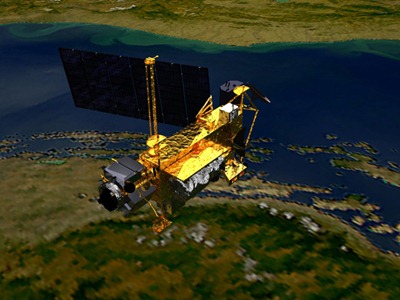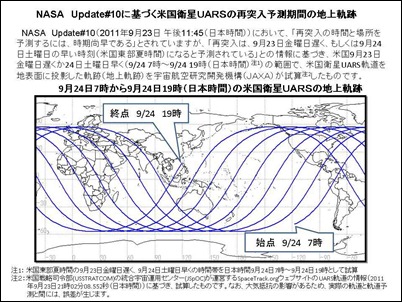« 永谷天満宮子ども神輿 | 最新記事 | 久しぶりの夕日 »
2011年9月24日
人工衛星はどこに落下するか

人工衛星や宇宙船などは、これまで五十数年間に4600回以上打ち上げられており、その結果、地球の周回軌道に漂う宇宙ゴミの問題が年々深刻化しています。
NASAによると、現在 US Space Surveillance Network が確認している10センチ以上の宇宙ゴミは約1万6000個、数センチのものは約50万個にも及ぶとされています。
既存の人工衛星の運用にも影響がでますし、大きな宇宙ゴミに関しては今回のような落下騒動にもなります。
今後、このような報道は増えていくことでしょう。
今日大気圏に落下するとみられているアメリカの大気観測衛星 UARS は、全長10m、重さは6トンという巨大なものです。

UARS ©NASA
NASAの速報(UARS Mission Update #10 によれば、日本時間9月23日午後11時30分現在、衛星は高度160-170kmの軌道を通っています。
また、日本時間24日午前8時30分の速報#11では衛星の高度は145-150km。 徐々に落下していることがわかります。落下予想時刻は日本時間正午12時から午後4時ごろとなりました。
第13報で落下時刻がだいぶ絞られました。日本時間で午後0時45分から午後1時45分となっています。
UARS Mission Updates
Update #10
2011年9月23日、23:45:08
As of 10:30 a.m. EDT on Sept. 23, 2011, the orbit of UARS was 100 miles by 105 miles (160 km by 170 km). Re-entry is expected late Friday, Sept. 23, or early Saturday, Sept. 24, Eastern Daylight Time. Solar activity is no longer the major factor in the satellite's rate of descent. The satellite's orientation or configuration apparently has changed, and that is now slowing its descent. There is a low probability any debris that survives re-entry will land in the United States, but the possibility cannot be discounted because of this changing rate of descent. It is still too early to predict the time and location of re-entry with any certainty, but predictions will become more refined in the next 12 to 18 hours.Update #11
2011年9月24日、8:30:46
As of 7 p.m. EDT on Sept. 23, 2011, the orbit of UARS was 90 miles by 95 miles (145 km by 150 km). Re-entry is expected between 11 p.m. Friday, Sept. 23, and 3 a.m., Sept. 24, Eastern Daylight Time (3 a.m. to 7 a.m. GMT). During that time period, the satellite will be passing over Canada, Africa and Australia, as well as vast areas of the Pacific, Atlantic and Indian oceans. The risk to public safety is very remote.Update #12
2011年9月24日、11:50:07
As of 10:30 p.m. EDT on Sept. 23, 2011, the orbit of UARS was 85 miles by 90 miles (135 km by 140 km). Re-entry is expected between 11:45 p.m. Friday, Sept. 23, and 12:45 a.m., Sept. 24, Eastern Daylight Time (3:45 a.m. to 4:45 a.m. GMT). During that time period, the satellite will be passing over Canada and Africa, as well as vast areas of the Pacific, Atlantic and Indian oceans. The risk to public safety is very remote.Update #13
2011年9月24日、13:55:17
As of 10:30 p.m. EDT on Sept. 23, 2011, the orbit of UARS was 85 miles by 90 miles (135 km by 140 km). Re-entry was expected between 11:45 p.m. Friday, Sept. 23, and 12:45 a.m., Sept. 24, Eastern Daylight Time (3:45 a.m. to 4:45 a.m. GMT). During that time period, the satellite was passing over Canada and Africa, as well as vast areas of the Pacific, Atlantic and Indian oceans. The risk to public safety was very remote. NASA is working to confirm the re-entry location and time and will provide an update shortly.
NASAの軌道をもとにJAXAが計算したUARSの軌道予想図です。
速報#11によれば、グリニッジ標準時GMT で9月24日午前3時45分から4時45分までに落下の可能性となっています。
日本時間では今日(9月24日)日本時間で午後0時45分から午後1時45分ということになります。
ということは、北アメリカ大陸~大西洋南部~アフリカ南部沖~インド洋あたりに落下する(した)可能性が高いということでしょうか。
もしも、落下時刻が後ろにずれて日本付近(太平洋沖)に人工衛星が落下するとすれば、注意すべき時間帯は午後7時過ぎです。
夕方までに未だ落下の報道がない場合、午後7時過ぎに日本の太平洋岸から南東の方向を見ると、もしかしたら落下の光跡を彼方に見ることができるかも?しれません。
※日本ので注意すべき時間帯を修正しました。



およそ12時間で8周しているので、1.5時間で1周。ということは終点から日本まで単純計算で3分程度。空気抵抗で終速は落ちるとしても、もし日本に到達するとすれば、19時半よりはかなり前になると思います。
投稿者 - | 2011年9月24日 09:46
-さま
コメントありがとうございました。
こちらでの記事修正投稿後にコメントをいただきましたので、行き違ってしまいました。
大気圏に斜めに突入することと対流圏での速度低下がどれくらいになるかですね。本文で日本付近を通過すると思われる時間帯を修正しました。
投稿者 kameno | 2011年9月24日 09:47